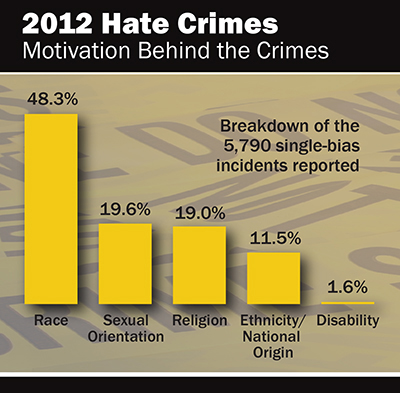Gather
December 2, 2013
 The 2012 FBI Hate Crime statistics report needs to be more transparent.
The 2012 FBI Hate Crime statistics report needs to be more transparent.
On Thursday, for example, a report from Glenn Smith and Natalie Caula Hauff of the local South Carolina news outlet, the Post and Courier, called to question the validity of the FBI report, which is based on data voluntarily provided by law enforcement agencies across the United States.
They write in part,
“Three agencies — Summerville police, Colleton County Sheriff’s Office and Citadel campus police — said they could not find records of any hate crime incidents last year, despite numbers attributed to them in the FBI report. Summerville Police Capt. Jon Rogers, for example, said the report’s listing of three race-related hate crimes in his town was incorrect. But Stephen G. Fischer, an FBI spokesman, said the report is highly accurate.”
Also, the report bizarrely lumps Hispanics in with white people as offenders, but still gives Hispanics their own category as victims, falsely giving the reader the impression that more white people commit hate crimes than actually do.
This is relevant, because a hate crime report in California for 2012, for example, found that “68% of anti-black crimes were committed by Latinos.” But this information is not captured for the official FBI statistics, which would lead readers to believe that these racially motivated hate crimes aimed at black Americans were all perpetrated by white people.
But these are some of the many other problems with the FBI statistics. The data presented in the report has nothing to back it up. In other words, the reader has to accept the numbers provided at face value. Details of the crimes themselves are not provided. And the crimes themselves do not even need a known offender to make the report.
Anonymous graffiti, for example, carries the same weight as a convicted crime. With the stories in abundance of hate crime hoaxes, as reported today by John Hawkins of Town Hall, the report should have more stringent reporting requirements. Only convicted crimes should be listed.
One of the biggest problems with the FBI Hate Crime statistics, however, is that justice is not blind when it comes to interracial crime. In many cases, crimes against white people are determined to be “not racially motivated,” such as in the high profile cases of the murders of Jason Hicks, Army Spc. Tevin Geike, and Delbert Belton.
Tevin Geike, for example, was stabbed to death in Washington State after being called a “cracker” according to more than one witness. He was not robbed. According to an article posted at Reuters, Lakewood Police Department spokesman Lieutenant Chris Lawler said
“The main suspect, Jeremiah Hill, did not make statement; so it’s unknown exactly why he did this.”
But Lawler knows it was not racially motivated.
This summer, the Examiner reported on the horrific beating of two young men in New Jersey by a group of Hispanic men. The family in that case were informed by police that “hate crimes don’t happen to white people,” despite the fact that the young men were not robbed and the perpetrators were never captured.
Sadly, America has found herself in an era of race-baiting politics, when racist phrases like “white privilege” are embraced by academia and award-winning journalists admit to suppressing information about race in crime in their reporting. It is not a stretch to believe that documenting “hate crimes” is less about spotting trends to address in society, but more about an overall agenda, an almost desperate attempt to keep racism alive.
Image Source: fbi.gov
 Daily Stormer The Most Censored Publication in History
Daily Stormer The Most Censored Publication in History


